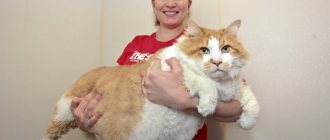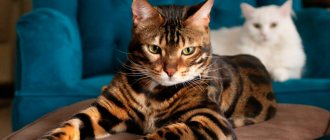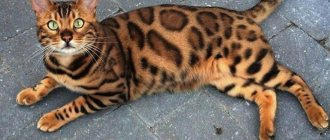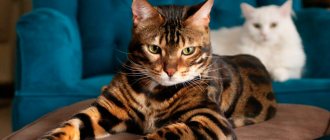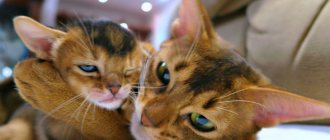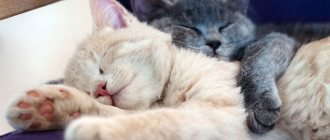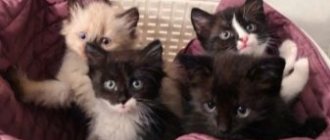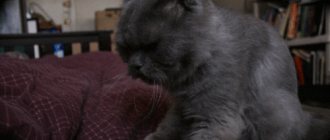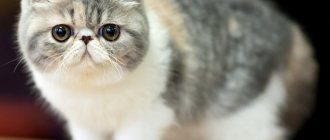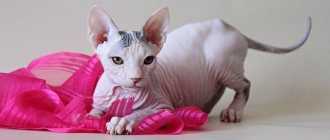Cats are primarily carnivorous animals. Nature created them this way. And despite the fact that these animals live side by side with humans for many centuries, there is an aggressive trait in each of them. Finding itself in a hopeless situation or angry, any cat can turn into a wild beast.
Photo: Pixabay.com
However, some cat breeds are more willful than others. She is much less tolerant not only of humans, but also of other animals. Therefore, they can show aggression without obvious reasons. These breeds differ in a number of features:
- A pronounced territorial instinct, which consists of distrust or attacking strangers or cats who find themselves in the cat’s territory.
- Expressed love for only one person (the owner) and indifference to everyone else.
- They tend to defend themselves by biting.
- Hybrid and exotic breeds that are closely related to wild cats.
It should be noted that these character traits do not prevent these cats from being affectionate and kind pets if they are properly raised and the people nearby respect their interests and do not violate their personal space.
We present to your attention a selection of the most aggressive cat breeds. The rating contains 12 breeds that show aggression most often.
Rating:
- Siamese
- Siberian
- Maine Coon
- Balinese
- Savannah
- Pallas' cat
- Mekong Bobtail
- Ocicat
- Turkish Angora
- Abyssinian
- Persian
- Ukrainian Levkoy
What cat breeds are recognized as the most evil?
We will not consider completely wild cats, such as the jungle cat, lynx, caracal and manul. These pets should be owned only at your own risk.
This article will present breeds recognized by international felinological organizations. They are all adapted to live with humans, but due to their characteristics they require a little more understanding and care.
Savannah
Savannah is a hybrid. It was obtained by crossing a wild serval with a bengal. Due to the presence of wild blood, the savannah has an independent and capricious character. Most often she shows aggression towards strangers.
Breeders recommend purchasing Savannahs from at least the second generation, that is, F2. Their genes contain only 25% of the serval, so they are much better at contact with humans.
All subsequent generations are even more similar to a domestic cat, but with the development of a softer disposition, their appearance significantly suffers. Minimal similarity to the Serval is typical for the F4 and F5 generations.
Despite their shortcomings, Savannahs are notable for their canine devotion. They constantly need communication and get along well with kids due to their playfulness.
Bengal
An elite breed, famous for its gracefulness and resemblance to a leopard. Obtained by crossing an ordinary domestic cat with a wild Far Eastern cat from Thailand. Uncontrollable character traits appear only in the first 3 generations of hybrids, so feel free to take a pet from the F4-F7 category.
Bengals are clean, easy to train and love active games. They are very social and easily get along even with dogs. Their disadvantages include a developed hunting instinct and the unacceptability of violent hugs. For this reason, it is better not to leave Bengals with small children and potential prey (fish, rodents, birds).
Chausie
The closest relatives of the Chausie are jungle cats, that is, this is another hybrid with wild cats. The most obstinate character is observed in the first 2 generations: F1 and F2. Everyone else is more flexible and calm.
Chausies love to make hiding places, are prone to “rock climbing” and love to swim. They become strongly attached to their owners, support children's fun with great enthusiasm and are not at all against the company of other four-legged animals.
Despite their loyal and friendly nature, the Chausie cannot be considered a patient breed. For twirling a mustache and stroking against the grain, they will definitely punish their offender.
It is equally important to remember about the developed hunting instinct. Keeping chausies together with hamsters and parrots can end very badly.
Maine Coon
Maine Coons are aboriginal cats with a pronounced territorial instinct. This is where their danger lies. They also do not tolerate familiarity. When meeting a stranger, Maine Coons try to keep their distance, assessing the danger of a potential enemy. If you don’t stoop to squeezing and forcibly picking her up, then over time the anger will definitely change to mercy.
Due to their gigantic size, Maine Coons often make a mess and can even cause serious injury to humans. They do both not out of malice, but banal caution is required from the owner.
Maine Coons are most active at night, so it is best to keep them in a spacious home. Otherwise, you will hardly be able to sleep, because it is almost impossible to barricade yourself in a small apartment.
Mekong Bobtail
Mekong Bobtails are ideal pets for families with children. They get along well with kids, love communication and are not at all opposed to tactile contact. Many pets take great pleasure in falling asleep with their owners in the same bed and constantly following them with their tails.
Because of their canine devotion, bobtails can be unusually jealous. They are also wary of strangers. We must not forget about the developed hunting instinct. For small pets, Mekong Bobtails pose an increased danger.
These cats become strongly attached to their household members and cannot stand being alone for long periods of time. They divide people into “us” and “strangers”, so at first they are hostile to their masters’ new passions. Over time, anger gives way to mercy, but at first it is better for a stranger to be careful and keep his distance.
Siberian
Despite all their friendliness, “Siberians” from birth do not trust strangers and cannot tolerate familiar treatment. Thanks to their playfulness, they are not against playing together with children, but they can also fight back without hesitation for a sloppy or downright painful touch.
“Siberians” are not intrusive and have great respect for those who observe a similar sense of tact. If the cat does not respond to your affection, leave him alone and wait for a more opportune moment.
British
“The British” are the true embodiment of calm and serenity. First of all, they are suitable for workaholics, as they do not mind daily absences at all.
Despite their unobtrusiveness, the “British” love affection, but with certain reservations. Most often, only one owner becomes their favorite, but even to him they are reluctant to kneel. For this reason, it is better to avoid too close contact in the form of hugs, limiting yourself to simple stroking.
Also, the “British” get along well with calm and slightly phlegmatic children who respect the independence of those around them. The peak of activity in these cats is observed in childhood and adolescence, but even mature pets sometimes run around the apartment in pursuit of a thrown ball.
Abyssinian
“Abyssinians” are very afraid of loud and sharp sounds. Because of this, they do not get along well with constantly crying babies and hyperactive older children. Despite this, the “Abyssinians” show patience to the last and only release their claws when they are truly disrespectful.
These cats closely resemble dogs. They quickly learn to fetch objects and need constant contact with humans. Without regular attention, they fall into deep depression and fall ill.
Siamese
The Siamese are known for their vindictive cunning. Thanks to their excellent memory and innate ingenuity, they often attack on the sly when the culprit has completely forgotten what he did. For this reason, when raising Siamese, you should not abuse punishments and use them only if there is a good reason.
Animals get along with children with varying degrees of success. The thing is that they are completely devoid of patience. Any mistake on the part of the little owner is immediately punished with a clawed paw. For children under 6-7 years old, it is better to choose someone friendlier.
Siamese have a negative attitude towards loneliness, because they are recognized as the most talkative cats. Also, these pets are very sensitive to human emotions. Frequent communication in a raised voice can make them withdrawn, cowardly and embittered.
Ocicat
Despite the strong resemblance to the ocelot, the Ocicat's closest relatives are the Abyssinians, Siamese and American Shorthairs. For this reason, they do not have pronounced wild instincts inherent in hybrids. But the parental traits are fully inherited:
- Siamese talkativeness, but without excessive talkativeness;
- Abyssinian contact.
Ocicats differ from the mentioned breeds only in that they are not at all afraid of strangers. They quickly find a common language with them and can even jump into their arms when they first meet them. Animals show complete indifference only to those who allow themselves too much or do not show reciprocal cordiality.
Ocicat aggression is usually only shown towards other pets and human feet. Both occur due to the developed hunting instinct. They can also be very jealous if the owner pays much more attention to another two-legged or four-legged household member.
Cathesian
Not the most common, but one that ranks among the top evil cat breeds is the Chartreuse or Cathesian. Cats of French origin are extremely jealous, considering themselves the only ones they love. They cannot stand competition, they do not want strangers and are afraid of them, and for this reason they do not get along with other pets at all. Their capricious nature also requires space for maintenance; a private house is perfect.
Self-sufficiency, impatience with changes in daily routine and habitat, and reluctance to forced hugs make Chartreux not the most desirable family members. But if they really love the owner, they will show him their affection in every possible way and seek attention.
How to raise such pets
All of the listed “mustaches” can be successfully trained at home. To correct unwanted behavior, it is necessary to gain the animal’s trust and directly influence the cause of its aggression.
Establishing trust
The cat will definitely trust you if you show him respect and do not punish him without reason. To do this you need:
- Maintain the inviolability of personal boundaries. Do not disturb your pet while sleeping and do not pick him up without permission. Be sure to convey this information to your children to avoid tears after receiving change.
- Apply punishments correctly and promptly. They are effective only at the moment of committing an offense and only in the absence of assault.
Don't forget about attention. Try to spend as much free time as possible with your mustachioed family member, so that he feels his importance and your love.
Maine Coon
Of the domestic cats, the largest is the Maine Coon, which has a massive body and a wide chest. A non-obese Maine Coon can weigh up to 15 kg. They are often bred as exotic cats. But they may not be harmless, sometimes they can show aggression, and the large size of the cat can mean more serious injuries. If a stranger enters the territory of the house, the Maine Coon may meet him aggressively. But at the same time, breeders note their flexibility and high intelligence - Maine Coons can pick up on the intonations of their owners and respond to their requests. They are very curious and therefore require close attention to themselves. They don’t like to be left alone, so if a Maine Coon needs to be left alone for a while, then you should provide it with toys, otherwise the owners will later regret leaving it. Maine Coons do not require special conditions to keep; they feel good in any climate. But during walks you should not leave them alone, as their mood can instantly change.
Causes of aggressive behavior
All domestic cats have the same reasons for their anger. In the first place are breed qualities. Bengals, British, Siamese cats have an innate tendency towards aggression. It manifests itself differently in everyone, but the predisposition is fixed by genetic development.
The second reason is improper upbringing. Any cat can become evil, even if it belongs to the order of decorative tigers or harmless ragamuffins.
Third – living conditions and stress. Loud sounds, unusual smells, lack of attention from the owner - the cat evaluates all the circumstances and reacts to them. Also, a cat’s mood changes during the mating period.
Chausie
The chausie is also not of the kindest disposition; it is wild and capricious, slightly reminiscent of a puma in appearance. The chausie is distinguished by its size and highly developed hunting instinct. There is no place for them in a small apartment because of their large dimensions and desire to run around, their love of occupying mezzanine and above closet spaces, creating reserves and secret storage areas, which the owners will periodically access.
Making a new friend
The undoubted advantage of outbred cats is that no costs are required to purchase them. Usually such pets are acquired through friends or through an advertisement. Often, stray kittens are picked up on the street. If an animal is taken from home and there is a choice, in order not to make a mistake with the character and health of the kitten, you need to take a closer look at the following signs:
- the kitten readily approaches you, tries to flirt and does not try to show aggressiveness;
- the kitten is distinguished by its external attractiveness, meekness, agility, playfulness, playfulness and does not look sad, dejected or apathetic;
- holds his head up normally and walks or runs with absolutely no limp;
- does not twitch his head, does not have a runny nose, cough, or other external painful signs;
- the kitten's skin looks clean and healthy, without irritation, dirt, scabs or flea excrement;
- the animal's coat is shiny and clean, without bald spots or tangles (matted);
- no liquid or other discharge from the eyes, nose and ears;
- the third eyelid (the so-called nictitating membrane) does not cover part of the eye;
- teeth look clean and free of tartar, there is no unpleasant odor from the mouth;
- The gums of a healthy kitten are pink and there are no signs of bleeding;
- the stomach feels quite strong and at the same time not bloated;
- the anus is clean, without remains of feces, there are no visible signs of diarrhea or worm segments (they, if present, come out of the anus and look like grains of rice).
It is recommended to wean a kitten from its mother no earlier than 2.5–3 months. At this age, the baby will tolerate separation without consequences for the psyche. He is already accustomed to the tray and “adult” food.
The offspring of outbred cats can be of a wide variety of colors
Savannah
The luxurious spotted color and rather impressive size of the savannah bring to mind associations more with a reduced sevral than with an ordinary domestic cat.
This cat breed is distinguished by fairly high intelligence. They are smart, always loyal to their owner and easy to train.
The owner can raise an excellent friend and companion from a cat of this breed, but other people around will forever remain strangers to her . Therefore, she will want to attack guests at home or passers-by on a walk if she feels that they pose a danger to the savannah itself or to the owner.
Chausie is the most predatory animal among cats, comparable in temperament to a puma
Chausie cats are quite similar to their wild feline counterparts. In some ways, their body structure resembles that of a puma. They are much larger in height and weight than ordinary domestic cats, although their silhouette is very slender and powerful.
This predator is ready to attack at any second. Considering their tendency to show aggression, a family that decides to adopt this animal should stop its attempts to play with its arms and legs from childhood, and also prohibit biting.
Abyssinian
The Abyssinian cat is an ancient breed. Her character resembles that of a dog. She is very active, playful, extremely energetic and easy to train. The Abyssinian has a hard time with loneliness and is prone to depression. Like representatives of the Siamese breed, Abyssinian cats can take revenge on household members for grievances caused. They can bite and scratch painfully.
Bengal
Another representative of the evil cat family is the Bengal, with a pronounced hunting instinct and incredibly impressive appearance. Many of the representatives of the Bengal breed have impulsive character traits, due to which the animal becomes aggressive, capable of even attacking the owner in case of contradictions.
Raising your voice, much less shouting, is not tolerated. Day after day, Bengals tirelessly drive everywhere, and this continues until old age. Not everyone will like this. If the owner does not want to get a pet that will constantly attack him, he needs maximum attention, affection and care for the representatives of the breed.
Manul is the closest relative of the wild lynx
Manul. An amazing animal, outwardly similar to the Angora and Persian breeds, but in terms of the structure of the skull it has much in common with the lynx. A relatively small animal, body length is usually 55-65 cm, weight 2-5 kg.
However, the cat appears to be quite large, with large fangs; the effect of increased size is created by the thick fur on the animal’s body. In times of danger, they prefer to hide in a secluded place. If it feels threatened by a person, it can easily attack him.
London in touch
In fact, London has nothing to do with it. But the British Shorthair is included in the ranking of the most evil cats. And you can’t say this at all, looking at the round face with wide open eyes. The British have a unique character. They do not tolerate disrespectful behavior towards them. These cats are generally not known for their patience. They are quite demanding and at the same time independent. Although the British breed is characterized as particularly attached to its owner.
jungle cat
Jungle cats can hardly be called domestic cats. Their appearance and temperament correspond to the nature of ferocious predators. To release their energy, they need a lot of free space, so keeping them in an apartment is inappropriate. Also, cats of this breed love to swim, so the ideal place to keep them is a country house with a nearby pond or swimming pool. In order for an animal to get used to a person, it must be taken into the family as a small kitten and gradually accustomed to people, paying a sufficient amount of attention. There are no hereditary diseases in jungle cats.

